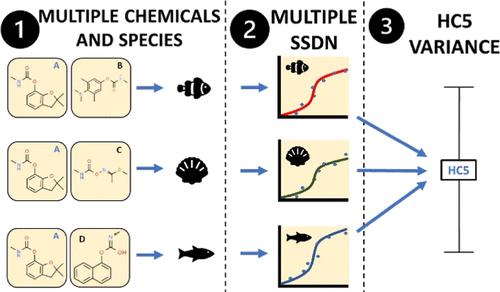当前位置:
X-MOL 学术
›
Environ. Sci. Technol.
›
论文详情
Our official English website, www.x-mol.net, welcomes your
feedback! (Note: you will need to create a separate account there.)
Advancing Fifth Percentile Hazard Concentration Estimation Using Toxicity-Normalized Species Sensitivity Distributions
Environmental Science & Technology ( IF 10.8 ) Pub Date : 2022-11-21 , DOI: 10.1021/acs.est.2c06857 Alexander K Dhond 1 , Mace G Barron 1
Environmental Science & Technology ( IF 10.8 ) Pub Date : 2022-11-21 , DOI: 10.1021/acs.est.2c06857 Alexander K Dhond 1 , Mace G Barron 1
Affiliation

|
The species sensitivity distribution (SSD) is an internationally accepted approach to hazard estimation using the probability distribution of toxicity values that is representative of the sensitivity of a group of species to a chemical. Application of SSDs in ecological risk assessment has been limited by insufficient taxonomic diversity of species to estimate a statistically robust fifth percentile hazard concentration (HC5). We used the toxicity-normalized SSD (SSDn) approach, (Lambert, F. N.; Raimondo, S.; Barron, M. G. Environ. Sci. Technol.2022,56, 8278–8289), modified to include all possible normalizing species, to estimate HC5 values for acute toxicity data for groups of carbamate and organophosphorous insecticides. We computed mean and variance of single chemical HC5 values for each chemical using leave-one-out (LOO) variance estimation and compared them to SSDn and conventionally estimated HC5 values. SSDn-estimated HC5 values showed low uncertainty and high accuracy compared to single-chemical SSDs when including all possible combinations of normalizing species within the chemical-taxa grouping (carbamate-all species, carbamate-fish, organophosphate-fish, and organophosphate-invertebrate). The SSDn approach is recommended for estimating HC5 values for compounds with insufficient species diversity for HC5 computation or high uncertainty in estimated single-chemical HC5 values. Furthermore, the LOO variance approach provides SSD practitioners with a simple computational method to estimate confidence intervals around an HC5 estimate that is nearly identical to the conventionally estimated HC5.
中文翻译:

使用毒性标准化物种敏感性分布推进第五百分位危害浓度估计
物种敏感性分布 (SSD) 是一种国际公认的危害估计方法,使用代表一组物种对化学品敏感性的毒性值的概率分布。 SSD 在生态风险评估中的应用受到物种分类多样性不足的限制,无法估计统计上稳健的第五百分位数危害浓度 (HC5)。我们使用毒性归一化 SSD (SSDn) 方法(Lambert, FN; Raimondo, S.; Barron, MG Environ. Sci. Technol. 2022, 56, 8278–8289),经过修改以包括所有可能的归一化物种,以估计氨基甲酸酯和有机磷杀虫剂组的急性毒性数据的 HC5 值。我们使用留一法 (LOO) 方差估计计算每种化学品的单一化学品 HC5 值的平均值和方差,并将其与 SSDn 和传统估计的 HC5 值进行比较。当包括化学分类群内标准化物种的所有可能组合(氨基甲酸盐-所有物种、氨基甲酸盐-鱼、有机磷-鱼和有机磷-无脊椎动物)时,SSDn 估计的 HC5 值与单一化学 SSD 相比显示出较低的不确定性和较高的准确性。建议使用 SSDn 方法来估计 HC5 计算物种多样性不足或估计的单一化学 HC5 值不确定性较高的化合物的 HC5 值。此外,LOO 方差方法为 SSD 从业者提供了一种简单的计算方法来估计 HC5 估计值周围的置信区间,该估计值与传统估计的 HC5 几乎相同。
更新日期:2022-11-21
中文翻译:

使用毒性标准化物种敏感性分布推进第五百分位危害浓度估计
物种敏感性分布 (SSD) 是一种国际公认的危害估计方法,使用代表一组物种对化学品敏感性的毒性值的概率分布。 SSD 在生态风险评估中的应用受到物种分类多样性不足的限制,无法估计统计上稳健的第五百分位数危害浓度 (HC5)。我们使用毒性归一化 SSD (SSDn) 方法(Lambert, FN; Raimondo, S.; Barron, MG Environ. Sci. Technol. 2022, 56, 8278–8289),经过修改以包括所有可能的归一化物种,以估计氨基甲酸酯和有机磷杀虫剂组的急性毒性数据的 HC5 值。我们使用留一法 (LOO) 方差估计计算每种化学品的单一化学品 HC5 值的平均值和方差,并将其与 SSDn 和传统估计的 HC5 值进行比较。当包括化学分类群内标准化物种的所有可能组合(氨基甲酸盐-所有物种、氨基甲酸盐-鱼、有机磷-鱼和有机磷-无脊椎动物)时,SSDn 估计的 HC5 值与单一化学 SSD 相比显示出较低的不确定性和较高的准确性。建议使用 SSDn 方法来估计 HC5 计算物种多样性不足或估计的单一化学 HC5 值不确定性较高的化合物的 HC5 值。此外,LOO 方差方法为 SSD 从业者提供了一种简单的计算方法来估计 HC5 估计值周围的置信区间,该估计值与传统估计的 HC5 几乎相同。











































 京公网安备 11010802027423号
京公网安备 11010802027423号